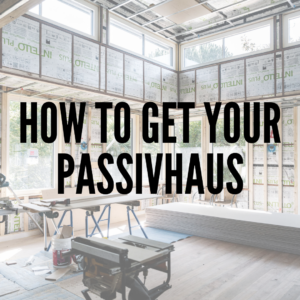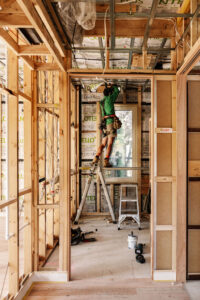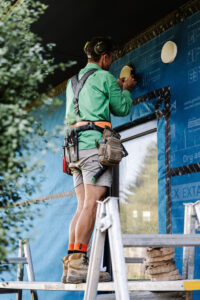Building a home should be a joyful collaboration, says Andy Marlow. Here's a roadmap for how to get to the certified Passivhaus performance you seek. Spoiler: PHPP files are not optional.

Envirotecture’s Director Andy Marlow provides a clear roadmap for HOW to get your Passivhaus:
I am not a lawyer but we have recently been exposed to various projects (by others) where homeowners and builders are in legal disputes over the home that has been delivered. Firstly, this is sad. Neither party is in a good place and there is a fair chance that neither was deliberately misleading.
The stories revolve around the discussions that were had about the project (lots of talk about Passivhaus) but that a Passivhaus, certified or not, was not delivered.
Passivhaus has taken off in Australia in recent years which is a great thing, but it is no surprise that increased numbers bring increased risk. The market is full of new players, as we were several years ago, and will continue to be for some time as people discover the benefits of the end product as well as the business advantages of delivering a product that does what is says on the box!
Over the past decade we have delivered many Passivhaus projects, so what are the critical elements that ensure you get what you pay for?
Design
The project must be designed in the Passive House Planning Package (PHPP). This does not just mean a feasibility study (although that is where you start) but that the final construction documents, engineering, ventilation planning, and window details are all incorporated into the thermal model to ensure it still meets the Passivhaus standard. This will inevitably involve some thermal bridge calculations unless your design is simple or you are fortunate enough to rely on the past experience (thermal bridge work expertise) of your Certified Passive House Designer (CPHD).

Documentation
Buildings are complicated things, even single family homes.
A Passivhaus needs to meet an air tightness requirement, as well as ensure that all insulation is well fitted and that all thermal bridges are mitigated. To expect a human to do all of this on site without a detailed roadmap is optimistic at best! Others may say courageous.
As a minimum, documentation needs to include clear drawings of the thermal envelope, window/door installation details especially door sills, all key junctions (floors to walls to roofs) and almost any junction involving steel and/or concrete.
Contract
No one likes contracts. They should be signed, filed in the bottom drawer and never see the light of day again. (And when things are going well between all parties, they can stay there! But if things go awry, you want to know the contract protects you).
That said, they should be thoroughly reviewed, understood and they should accurately represent the project you think you have had designed (and are about to pay to build).
Building contract legislation is state-based which is not especially helpful. However, in all, there are some ‘industry standard’ contracts that make up a large majority of those used.
These standard contracts are produced by various industry bodies. It is no surprise that the organisations that produce contracts tend to have clauses that favour their members. As homeowners do not have a member organisation, they are not well represented in this field. One exception is a NSW contract by the state government, the Fair Trading contract by the Department of Fair Trading. Other states may have a similar version, but I am unaware of them.
Traditionally, architects administered contracts, acting as intermediary between client and builder. While these contracts still exist, they represent a very small share of the market. This is partly due to the low percentage of homes designed by architects but also the reluctance of banks to lend against these types of contracts; they are not a simple fixed price, pre-defined staged payment contract. They do solve a lot of issues though!
I repeat, I am not a lawyer. However, the one trait we see in the Industry produced contracts is a’ hierarchy of documents’ that does not put the design front and centre. Legally, it needs to be understood which documents trump the others. In practice this means that if a ‘builders quote’ is at the top of the tree then any specifications, design drawings, or details that follow are of lesser weight; arguably worthless.
Ensuring the design that you have probably poured your heart, soul and possibly a lot of money into is contractually required to be delivered seems obvious yet seems too often not be the case.
The flip side to this is that a contract should not be unfair to either party. In our view this means that the risks should remain with those who can best manage and/or mitigate them.
We believe it is unfair to contractually require a builder to ‘deliver a certified Passivhaus’ unless they are also the Passivhaus designer. However, we do believe that they can be contractually obligated to deliver a building that if constructed as documented and meets the air tightness requirements for Passivhaus certification.
The builder, possibly via their subcontractors, is also best placed to ensure that the ventilation system is correctly commissioned.

Construction Quality
This is arguably the biggest challenge Passivhaus will face in the single residential space in the next few years. As the builder market transitions from those who care passionately and have meticulous attention to detail to those who just see a business opportunity, the need for monitoring of build quality will increase.
The current Quality Assurance (QA) processes around certification are a big help. However, it is possible for things to be missed, innocently or not, and for mistakes to be discovered too late when rectification is costly.
The current quality of new homes delivered across the nation suggests a consistent problem in build quality and a consistent failure of building inspectors to ensure that compliant, quality homes are delivered. This is a depressing fact, yet the evidence is strong.
There is an emerging need for more inspections during construction (NSW generally only has 7 for a new home, whereas California has 29). We respectfully suggest that most current inspectors are inadequately trained to perform this task; the goal posts have moved while the majority of the system has not. This provides both a challenge and opportunity to the Passivhaus community to fill the void in a way that adds value. To not solve this issue brings risk to all leveraging off the Passivhaus quality brand!
Passivhaus Certification
The realisation is gradually percolating through the construction sector that Passivhaus is a Quality Assurance system masquerading as a health and comfort standard that happens to deliver buildings in an energy efficient way.
For anyone building a home to the Passivhaus standard the additional work to achieve certification is small when compared to the time, effort and money that go into the house itself.
The process ensures that the whole team must do their part which, with the right humans involved, it can be a wonderful experience; everyone pulling together to achieve a common goal.
Who should be legally responsible for this is interesting; we’d suggest ‘no-one’! We circle back to risks and people’s ability to mitigate them. The Certified Passivhaus Designer has a responsibility to design the certifiable Passivhaus, the builder has a responsibility to build what was documented and contracted but neither have the control needed to guarantee the certified PH outcome.
Is this fair? It depends. In reality, if a homeowner wanted to guarantee a certified Passivhaus building they would be best placed to put that responsibility on the builder. They would, we suspect, enter into a Cost Plus building contract. This ensures that whatever unforeseen circumstances arise, the builder can do whatever is required, at whatever cost, to ensure the building becomes certified.

Pulling together
All good QA systems rely on a repeatable, reliable, and consistent process. A certifiable Passivhaus requires a competent CPHD, a robust set of contract documents with a robust contract and a competent builder.
The fact that building a home appears to have become a stressful experience is a poor reflection on our industry. It should be a joyful design collaboration between aligned humans.
Footnote:
Architecture
I am an architect (and CPHD).
I have deliberately not mentioned the A word yet. Architecture is the element that makes the building sing. A good architect will deliver a design that can meet the Passivhaus standard because of, not in spite of, the design.
While you don’t need good architecture to have a certifiable Passivhaus it is much nicer when you do.
Author: Andy Marlow, Envirotecture Director.

Andy Marlow
,
Company
Andy joined Dick Clarke at Envirotecture as a young architect, gaining significant experience in designing genuinely sustainable buildings, both residential and non-residential, in Australia and overseas. After a stint at a large corporate practice, Andy returned to Envirotecture as a director in 2014. He went on to found Passivhaus Design & Construct in 2020, in order to make Passivhaus performance more accessible for more people.
Discover our people (and what it's like to work here) and awards we've won.
Explore our expansive library of resources for people interested in sustainable, healthy homes.



